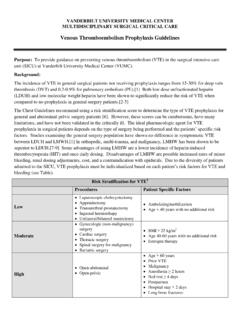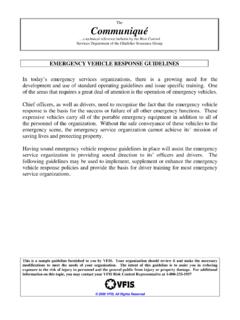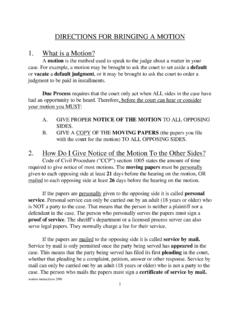Transcription of ROTATOR CUFF HOME EXERCISE PROGRAM - VUMC
1 ROTATOR CUFFHOME EXERCISEPROGRAM Contact us!Vanderbilt Sports MedicineMedical Center East, South Tower, Suite 32001215 21st Avenue SouthNashville, TN 37232-8828 For more information on this and other injuries see our website: information is intended for education of the reader about medical conditions and current treatments. It is not a substitute for examination, diagnosis, and care provided by your physician or a licensed healthcare provider. If you believe that you, your child, or someone you know has the condition described herein, please see your healthcare provider. Do not attempt to treat yourself or anyone else without proper medical attention. All rights reserved 2011, Vanderbilt University, Vanderbilt University Medical Center, Vanderbilt Children s by the MOON Shoulder GroupCopyright 2011 Vanderbilt Sports Medicine2 Introduction The MOON Shoulder group is a Multi-center Orthopaedic Outcomes Network.
2 In other words, it is a group of doctors from around the country working together to do research so they can give patients with shoulder problems the best possible care. Your doctor, athletic trainer or physical therapist can help guide you through this PROGRAM which is broken up into three parts: Range of motion you should do this every day to help get your motion back. Flexibility you should do this every day to help stretch tight tissues. Strengthening you should do this 3 or 4 days each week to help get your strength back. For most of the exercises you will do a certain number of repetitions (or reps) and a certain number of sets. Example: 3 sets / 10 reps Set 1: Do the EXERCISE 10 times and then rest for a few seconds, Set 2: Do the EXERCISE 10 times and then rest for a few seconds, Set 3: Do the EXERCISE 10 times and then rest for a few seconds.
3 Then move onto the next EXERCISE . 15 14 3 Please do not add, skip or alter any of the exercises without talking to your doctor first. DVD At the back of this booklet you will also find a DVD. The DVD shows you how to do all of the exercises in this booklet. Some points to remember: 1. The Range of motion and Flexibility exercises can be done every day, while the strengthening exercises should be done 3 or 4 times per week. 2. With the Range of motion exercises, it may be easier and less painful to start while lying on your back. When that becomes comfortable, you can do the exercises standing. 3. With strengthening, if you have moderate or severe pain with any of the exercises, you should decrease the resistance, decrease the amount of times you do the EXERCISE , or skip the EXERCISE until you can do it without pain.
4 If you have any questions after reading the booklet or watching the DVD, talk to your doctor, physical therapist, or athletic trainer. If you are unable to view the video online, ask yournurse for a DVD. The physical therapy PROGRAM used in this study may be downloaded at the following sites: Patient Home Physical Therapy Rehabilitation Directed Physical Therapy Rehabilitation Home Physical Therapy Rehabilitation Video: The red arrows point to the injured shoulder in the pictures where it may not be clear. Range of motion Exercises Do these every day 1. Pendulum exercises. Move your body and let the movement of your body move your shoulder. Example: Rest your good hand on a table and bend over a little at your waist.
5 Make circles with your hips/body which will cause your injured arm to make circles. Repeat this by moving your hips/body in different directions . Do not use your shoulder muscles. Do each motion 20 times. 2. Posture exercises. These exercises should be done within the pain free range. In other words you should not have any pain while doing these exercises. Do this EXERCISE 20 times. Put your hands on your hips, lean back and hold for 20 seconds. Let the injured arm hang over the side of the table. Make 20 small circles in one direction and then 20 small circles in the other direction. Make forward and backward motions 20 times and then side to side motions 20 times. 13 Begin by lying flat on your back (1).
6 While lying on your back lift your injured arm over your head, using your good arm to help. Once this gets easier, try raising the injured arm by itself. Once this gets easier, try raising the injured arm with a small weight in your hand. Once this gets easier raise your back by resting on pillows or sitting in a recliner (2) and start the whole process over. Keep raising your back and starting the process over again until you are standing straight up. Jackins Exercises If you have a hard time raising your arm, you should try these Jackins exercises. Do 3 sets / 10 reps. for each EXERCISE . Figure 1 Figure 2 Figure 3 Again, if you have any questions after reading this booklet or watching the DVD, talk to your doctor, physical therapist, or athletic trainer.
7 12 8. Push Up Plus: Do 3 sets / 10 reps. 9. Posterior Deltoid: Do 3 sets / 10 reps. Do a pushup (either on your hands or forearms) and then really push to bring your spine to the ceiling. Kneeling on the floor, place your hands or forearms on the floor. Start by doing a push-up, then round your back. Really push to try to touch your spine to the ceiling. Lying on your stomach hang your arm over the side of the bed or couch. While holding a weight, bring the arm out to the side and hold for 20 seconds. 5 Pinch the back of the shoulder blades together using good posture. Shoulder Shrugs: Pull shoulders up and back and hold. 3. Active assisted range of motion . Use a cane/broomstick/pulley system so the good arm moves the injured arm.
8 Do 3 sets / 10 reps for each EXERCISE 4. Active training of the scapula muscles. Two exercises are shoulder shrugs and pinching your shoulder blades. Do 3 sets/10 reps for each EXERCISE . Figure 1 Figure 2 Figure 3 Lying on your back, hold the cane with both hands. Raise your arms using the good arm to help guide the injured arm (Figure1). Next use the good arm to move the injured arm to the side (Figure 2). Lastly, use the good arm to move the injured arm up to the side and up (Figure 3) You may start to use your injured arm more as it starts to feel more comfortable. Again as you start to feel more comfortable you can also do these standing up. 6 5.
9 Active range of motion . Raise your injured arm while looking at yourself in the mirror be sure not to hike or raise your shoulder! You can place your hand (from your good arm) on top of your injured shoulder to make sure the muscles are relaxed. Do 3 sets / 10 reps. Flexibility Do these every day Hold each stretch for 30 seconds and rest for about 10 seconds in between. Repeat five times per day. 1. Door Stretch. A B Place your hands or forearms at shoulder level on each side of a door frame or in a corner of a room (A). Lean forward into door or corner and hold. Next place your hands or forearms over your head on each side of the door, lean forward and hold (B).
10 In front of a mirror practice raising your arm in front of your body without shrugging your shoulder. 11 Stand with weights in hands. Roll shoulders back and hold. 5. Chair Press: Do 3 sets / 10 reps. 6. Shrugs: Like the shoulder shrugs (page 5), except this time you use weights. Do 3 sets / 10 reps. 7. Press Up: Do 3 sets / 10 reps. Lie on back, elbow locked straight, arms stretched up towards the ceiling with weights in hands. Move/Push arms up towards the ceiling as far as possible. While seated put your hands on the seat or on the arm rests. Then press down with your arms, lifting your body off chair. Try to keep your back straight. 10 Postural / Periscapular Muscle Strengthening 3. Rows: Do 3 sets / 10 reps.
















